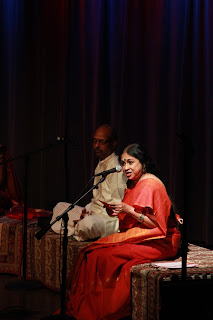By Shankar Ramachandran
The title of the JustUs Repertory Theater production, Born to Sing: a shy girl from Madurai, was as seductive as it was appropriate. We at Dhvani; the India Performing Arts Society of Central Ohio immediately booked the show for the first day of our three-day celebration of MS Subbulakshmi Centenary. I have seen and heard many of Gowri Ramnarayan’s theater and music productions and was aware of her ability to mould and wrest unique performances out of youthful performers. But a musical presentation about MS poses unique challenges. I couldn’t help but wonder how this group was going to pull this off. I tried to shake off my jitters. The song list was impressive and, like most of MS’s repertoire, these would be very familiar to many in the audience.
As luck would have it I was very busy with logistical and other issues during the days leading up to the festival and my fears and concerns didn’t get much attention, care or feeding. One of the singers was unwell and watching the rather low-tech ministrations of honey, turmeric, garlic and pepper concoctions set my jitters in hyper mode again and didn’t do much to assuage my pangs. On the day of the show, by the time the stage lights dimmed at the packed theater, I was just a bundle of taut nerves.
Once the program began I realized that my fears were quite unnecessary. Dr. Ramnarayan’s seemingly effortless and informal introduction captured the audience and the “dream team” never did let them go till the final chant from the Gita at the show’s conclusion. At the very beginning Gowri set the stage for introducing the iconically familiar MS to the audience under some less familiar lights. MS, the personification of South Indian traditional womanhood was revealed as having deep commitment to social and political reforms. As the program wound on, Gowri skillfully painted an intimate portrait of MS and Sadasivam as a couple who willfully and effectively pursued their vision of a better India through the music of Subbulakshmi.
What about the musician’s on stage? They too wove their mesmeric spells as Gowri deftly handed the reins to each of them in turn. Aditya and Sushma each sang the familiar MS repertoire songs with involvement. While their renditions revealed what must have taken months of training, their presentations were anything but casual. There was sincerity, concentration and worshipfulness in every phrase. Aditya’s Khamas followed by Brochevarevarura and Sushma’s Hindolam and Maa Ramanan were both weighty and mellifluous. Neither attempted to sing the same sangathis nor attempt the same alapana phrases, as MS would have. But both of them left the audience breathless and eager to hear more. Tagore’s Mallika Boney and Naam Japana stole the show for their soulful poetry and expressions of deep human longing, which flowed through Sushma and Aditya’s respective imaginative renditions. Violin, mridangam, tabla and flute were interwoven in a collage of colorful sounds; subtle, myriad and heard without loudness. Shreya seemed to lead off effectively; switching slides seamlessly form song to song and from sruti to sruti. The instrumentalists also provided a romantic interlude with the songs from Sakuntalai; a useful ploy in the structure to give the audience a break from the more serious and more demanding elements of the show.
It could not have been easy for these artists to leap from song to song, each so different in structure, in language and emotional impact, throughout the two hour event. Practice and effort was evident as was each of their underlying talent and commitment to the production. Ramesh Babu and Thyagarajan Ramani rounded out this team; Ramesh with his seasoned fingering and gumukii used to change the impact and to create the illusion of changes in nadai. And Thyagarajan’s flute added the colors of innocence and of song, effectively creating a sense of storytelling, which was skillfully exploited by Gowri’s direction and her narrative.
 The end of the show came reluctantly. The photograph of MS on the stage now seemed three-dimensional. The audience didn’t want to leave and many of them milled about in the lobby in animated and excited discussions. Everyone who attended could agree that it was a most appropriate beginning to our three-day MS Centenary celebration. It was great entertainment, it was solid and soulful music, it was an appropriate semi-biographical introduction to MS Subbulakshmi, it was good theater and a sincere effort.
The end of the show came reluctantly. The photograph of MS on the stage now seemed three-dimensional. The audience didn’t want to leave and many of them milled about in the lobby in animated and excited discussions. Everyone who attended could agree that it was a most appropriate beginning to our three-day MS Centenary celebration. It was great entertainment, it was solid and soulful music, it was an appropriate semi-biographical introduction to MS Subbulakshmi, it was good theater and a sincere effort.No celebration of MS Subbulakshmi and her legacy would be complete without an effort to help others. In tribute and celebration of the life work of MS and Sadasivam, the members of the audience opened more than their hearts. They donated enough money to perform cleft palate surgery for eight children and to provide lunch for 50 children for six months.

